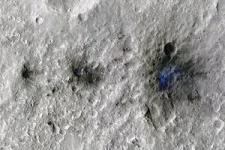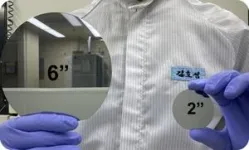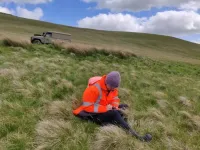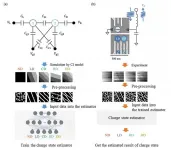(Press-News.org) Seismic signals have suggested Mars gets hit by around 300 basketball-sized meteorites every year, providing a new tool for dating planetary surfaces.
The new research, led by scientists at Imperial College London and ETH Zurich working as part of NASA's InSight mission, has shed light on how often ‘marsquakes’ caused by meteorite impacts occur on Mars.
The researchers found that Mars experiences around 280 to 360 meteorite impacts every year that produce craters larger than eight metres in diameter and shake the red planet’s surface.
The rate of these marsquakes, which were detected by InSight’s ‘seismometer’ – an instrument capable of measuring the slightest ground movements – exceeds previous estimates based on satellite images of Mars’ surface.
The researchers say these seismic data could be a better, more direct way of measuring meteorite impact rates, and could help scientists date planetary surfaces across the Solar System more accurately.
Study co-first author Dr Natalia Wojcicka, Research Associate at Imperial College London’s Department of Earth Science and Engineering, said: “By using seismic data to better understand how often meteorites hit Mars and how these impacts change its surface, we can start piecing together a timeline of the red planet’s geological history and evolution.
“You could think of it as a sort of ‘cosmic clock’ to help us date Martian surfaces, and maybe, further down the line, other planets in the Solar System.”
The study is published in Nature Astronomy.
Impact craters as cosmic clocks
For years, scientists have used the number of craters on Mars and other planets’ surfaces as ‘cosmic clocks’ to estimate planetary age – with older surfaces on planets pitted with more craters than younger ones.
To calculate planetary age in this way, scientists have traditionally used models based on craters on the Moon to predict the rate of meteorite impacts of different sizes over time. To apply these models to Mars, they need to be adjusted for how the atmosphere might stop smallest impactors from hitting the surface and Mars’s different size and position in the Solar System.
For small craters less than 60 metres wide, Mars scientists have also been able to observe how often new craters form using satellite images – but the number of craters found in this way is much lower than expected.
This new research, which is part of the InSight mission to understand the seismic activity and internal structure of Mars, researchers identified a previously unrecognised pattern of seismic signals, as produced by meteorite impacts. These signals stood out for their unusually greater proportion of high frequency waves compared to typical seismic signals, as well as other characteristics, and are known as ‘very high-frequency’ marsquakes.
The researchers found the rate of meteoroid impacts to be higher than previously estimated by looking at freshly formed craters captured by satellite images and in agreement with extrapolating data from craters on the Moon’s surface.
This highlighted the limitations of previous models and estimates, as well as the need for better models to understand crater formation and meteorite impacts on Mars.
The power of seismic data
To address this, the team of scientists used NASA's InSight lander and its extremely sensitive seismometer, SEIS, to record seismic events possibly caused by meteorite impacts.
SEIS detected seismic signatures characteristic of these very high-frequency marsquakes, which researchers found to be indicative of meteoroid impacts and different from other seismic activity.
Using this new method for detecting impacts, the researchers found many more impact events than predicted by satellite imaging, particularly for small impacts that produce craters only a few metres across.
Study co-author Professor Gareth Collins at Imperial College London’s Department of Earth Science and Engineering said: “The SEIS instrument has proven to be incredibly successful at detecting impacts – listening for impacts seems to be more effective than looking for them if we want to understand how often they occur.”
Improving our understanding of the Solar System
Researchers believe that deploying smaller, more affordable seismometers on future landers could further enhance our understanding of Mars’ impact rates and inner structure. These instruments would help researchers detect more seismic signals, providing a more comprehensive dataset for understanding meteorite impacts on Mars and other planets, as well as their inner structures.
Dr Wojcicka said: “To understand the inner structure of planets, we use seismology. This is because as seismic waves travel through or reflect off material in planets’ crust, mantle, and core, they change. By studying these changes, seismologists can determine what these layers are made of and how deep they are.
“On Earth, you can more easily understand the inner structure of our planet by looking at data from seismometers placed all around the globe. However, on Mars there has been only one – SEIS. To better understand Mars’ inner structure, we need more seismometers distributed across the planet.”
As well as the new research published in Nature Astronomy, the team are also involved in another study publishing in Science Advances today, which used images and atmospheric signals recorded by InSight to estimate how often impacts occur on Mars. Despite using different methods, both studies reached similar conclusions, strengthening the overall findings.
END
Surprising meteorite impact rate on Mars can act as ‘cosmic clock’
2024-06-28
ELSE PRESS RELEASES FROM THIS DATE:
Air pollution exposure during childhood linked directly to adult bronchitis symptoms in new research
2024-06-28
A new study brings fresh revelations about the connection between early-life exposure to air pollution and lung health later in life. A research team led by the Keck School of Medicine of USC has shown that exposure to air pollution during childhood is directly associated with bronchitis symptoms as an adult.
To date, many investigations in the field have established intuitive links that are less direct than that: Air pollution exposure while young is consistently associated with lung problems during childhood — and childhood lung problems are consistently associated with lung issues as an adult.
The current study, published in the American Journal of Respiratory ...
Kids given ‘digital pacifiers’ to calm tantrums fail to learn how to regulate emotions, study finds
2024-06-28
Children learn much about self-regulation – that is affective, mental, and behavioral responses to certain situations – during their first few years of life. Some of these behaviors are about children’s ability to choose a deliberate response over an automatic one. This is known as effortful control, which is learned from the environment, first and foremost through children’s relationship with their parents.
In recent years, giving children digital devices to control their responses to emotions, especially if they’re negative, has ...
No evidence that England’s new ‘biodiversity boost’ planning policy will help birds or butterflies
2024-06-28
A new legal requirement for developers to demonstrate a biodiversity boost in planning applications could make a more meaningful impact on nature recovery if improvements are made to the way nature’s value is calculated, say researchers at the University of Cambridge.
From 2024, the UK’s Environment Act requires planning applications to demonstrate an overall biodiversity net gain of at least 10% as calculated using a new statutory biodiversity metric.
The researchers trialled the metric by using it to calculate the biodiversity value of 24 sites across England. These sites have all been monitored over the long-term, allowing the team to compare biodiversity ...
Visual explanations of machine learning models to estimate charge states in quantum dots
2024-06-28
A group of researchers has successfully demonstrated automatic charge state recognition in quantum dot devices using machine learning techniques, representing a significant step towards automating the preparation and tuning of quantum bits (qubits) for quantum information processing.
Semiconductor qubits use semiconductor materials to create quantum bits. These materials are common in traditional electronics, making them integrable with conventional semiconductor technology. This compatibility is why scientists consider them strong candidates for future ...
The future of metals research with artificial intelligence
2024-06-28
A research team led by Professor Hyoung Seop Kim from the Graduate Institute of Ferrous & Eco Materials Technology and the Department of Materials Science and Engineering and Jeong Ah Lee, a PhD candidate, from the Department of Materials Science and Engineering, in recent collaboration with Professor Figueiredo from Universidade Federal de Minas Gerais's Department of Metallurgical and Materials Engineering in Brazil, has developed an optimal artificial intelligence model to predict the yield strength of various metals, effectively addressing traditional cost and time limitations. This research has been published in the online edition of Acta Materialia, an ...
Tissue bridges are reliable predictors of recovery from cervical spine injuries
2024-06-28
The results of the longitudinal study “Prognostic value of tissue bridges in cervical spinal cord injury” have the potential to change clinical practice. They have just been published in The Lancet Neurology, the world’s leading journal of clinical neurology. The team led by lead author Dr. Dario Pfyffer and senior author Prof. Dr. med. Patrick Freund from Balgrist University Hospital and the University of Zurich, which includes SCI experts from around the world, has successfully developed models that incorporate tissue bridges in the spinal cord in a large, multicenter cohort of patients with cervical SCI for improved prognosis of clinical outcomes. These ...
Junior rank, male sex, younger age strongly linked to ‘harmful gambling’ among UK military
2024-06-28
Several indicative factors, including junior rank, male sex, and younger age, are strongly linked to ‘harmful gambling’ among serving UK military personnel, finds an analysis of survey responses, published online in the journal BMJ Military Health.
Harmful gambling refers to the toll taken on finances, health, personal relationships, and work: nearly 1 in 4 respondents reported one or other of these effects over the past year.
The findings prompt the researchers to call for the prioritisation of better, earlier, and targeted support to stave off the harmful consequences of ...
Poorer teen mental ability linked to as much as tripling in stroke risk before age of 50
2024-06-28
A lower level of mental ability during the teenage years may be linked to as much as a tripling in the risk of having a stroke before the age of 50, finds research published online in the Journal of Epidemiology & Community Health.
The observed associations held true even after factoring in current diabetes and limiting the age of a first stroke up to 40, prompting the researchers to suggest that more comprehensive assessments beyond traditional stroke risk factors are now needed to stave off disability and death.
Recent evidence suggests that cases of stroke ...
Adults conceived by donors left behind by fertility industry
2024-06-28
Children conceived by using egg or sperm donors have the same well-being outcomes as non-donor conceived people.
However, they are more likely to have identity difficulties and issues with trust. Secrecy and anonymity about their genetic parentage can have a profound impact on well-being say authors. They warn that children and adults conceived using donor gametes have not been centred in the assisted reproductive industry and more information is needed about adult wellbeing.
The study is published today in the British Journal of Obstetrics and Gynaecology by researchers King’s College London. The study is the first systematic ...
Novel method optimizes extraction of antioxidant and colorant from jabuticaba peel
2024-06-28
Scientists at the State University of Campinas (UNICAMP) in Brazil and the University of Cadiz (UCA) in Spain have successfully deployed a novel method of extracting high-value-added chemical compounds from the peel of jabuticaba (Plinia cauliflora). The method, which simplifies the process and enhances its efficiency, is described in an article published in Journal of Food Composition and Analysis.
The aim was to optimize extraction of anthocyanin, a potent antioxidant found in strawberries, blackberries and raspberries as well as jabuticabas, among other sources. It has anti-inflammatory effects and is also a natural ...





